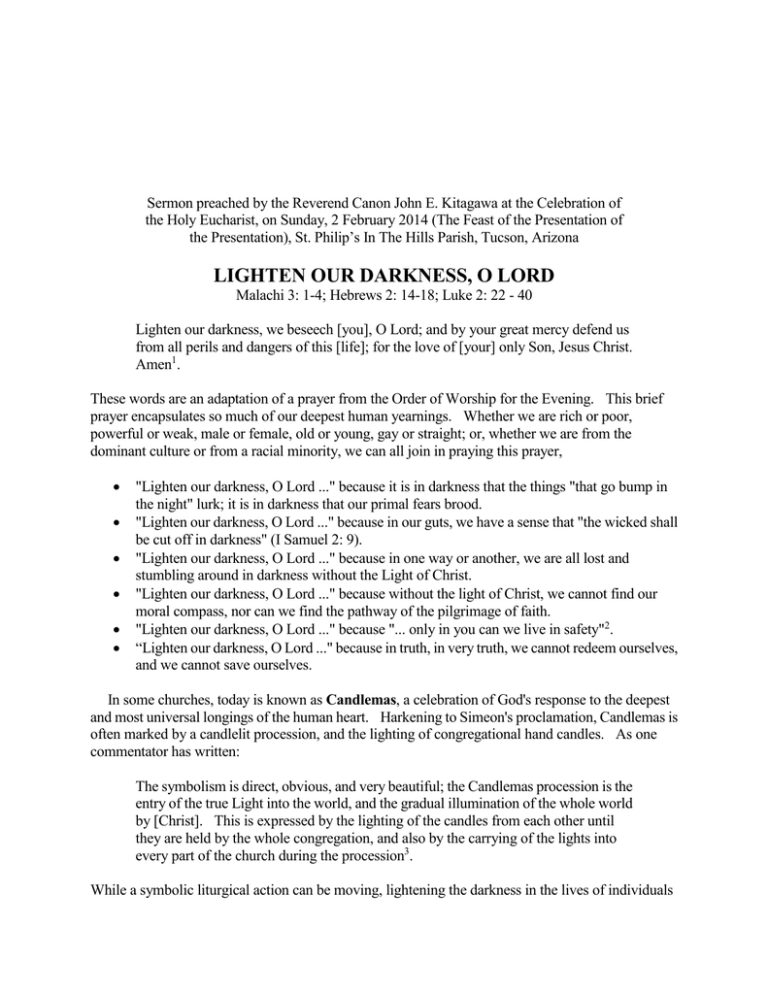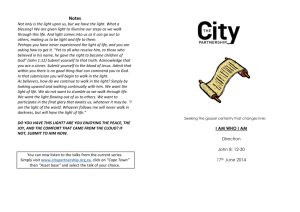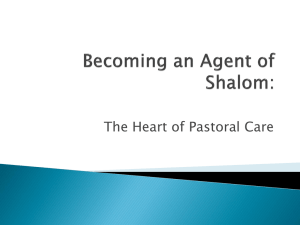lighten our darkness, o lord - St. Philip's in the Hills Episcopal Church
advertisement

Sermon preached by the Reverend Canon John E. Kitagawa at the Celebration of the Holy Eucharist, on Sunday, 2 February 2014 (The Feast of the Presentation of the Presentation), St. Philip’s In The Hills Parish, Tucson, Arizona LIGHTEN OUR DARKNESS, O LORD Malachi 3: 1-4; Hebrews 2: 14-18; Luke 2: 22 - 40 Lighten our darkness, we beseech [you], O Lord; and by your great mercy defend us from all perils and dangers of this [life]; for the love of [your] only Son, Jesus Christ. Amen1. These words are an adaptation of a prayer from the Order of Worship for the Evening. This brief prayer encapsulates so much of our deepest human yearnings. Whether we are rich or poor, powerful or weak, male or female, old or young, gay or straight; or, whether we are from the dominant culture or from a racial minority, we can all join in praying this prayer, "Lighten our darkness, O Lord ..." because it is in darkness that the things "that go bump in the night" lurk; it is in darkness that our primal fears brood. "Lighten our darkness, O Lord ..." because in our guts, we have a sense that "the wicked shall be cut off in darkness" (I Samuel 2: 9). "Lighten our darkness, O Lord ..." because in one way or another, we are all lost and stumbling around in darkness without the Light of Christ. "Lighten our darkness, O Lord ..." because without the light of Christ, we cannot find our moral compass, nor can we find the pathway of the pilgrimage of faith. "Lighten our darkness, O Lord ..." because "... only in you can we live in safety"2. “Lighten our darkness, O Lord ..." because in truth, in very truth, we cannot redeem ourselves, and we cannot save ourselves. In some churches, today is known as Candlemas, a celebration of God's response to the deepest and most universal longings of the human heart. Harkening to Simeon's proclamation, Candlemas is often marked by a candlelit procession, and the lighting of congregational hand candles. As one commentator has written: The symbolism is direct, obvious, and very beautiful; the Candlemas procession is the entry of the true Light into the world, and the gradual illumination of the whole world by [Christ]. This is expressed by the lighting of the candles from each other until they are held by the whole congregation, and also by the carrying of the lights into every part of the church during the procession3. While a symbolic liturgical action can be moving, lightening the darkness in the lives of individuals 2 and communities is not so simple. So, for the next few minutes, I want to loosen the fabric of today's Gospel story. I want to reflect with you on some of the fibers which make up the tapestry, and then I hope to bring it all back together again. Let me begin with something I picked up years ago at a Vestry Workshop. This quotation speaks to a common thread running through today’s Gospel: When God breaks in on a sufficiently prepared people, a new, outgoing, spontaneous, free and joyous [faith] emerges. Notice the description of Simeon: ... this man was righteous and devout, looking forward to the consolation of Israel, and the Holy Spirit rested on him (Luke 2: 25). I want to suggest that being sufficiently prepared was essential to Simeon's ability to discern the baby Jesus as God breaking into the world in a new way, to see Jesus as: [God's] salvation, which [God] prepared in the presence of all peoples, a light for revelation to the Gentiles and for glory to your people Israel (Luke 2: 30-32). Remember how Anna was described She never left the temple, but worshiped there with fasting and prayer night and day (Luke 2: 37). I want to suggest that being sufficiently prepared was critical to Anna's ability to respond to the baby Jesus. As she recognized Jesus for who he was, she immediately began: to praise God and to speak about the child to all who were looking for the redemption of Jerusalem (Luke 2: 28). Both of these responses to Jesus are new, outgoing, spontaneous, free and joyous expressions of faith. They are proclamations that God lightens the darkness. Let me skate on the edge of theological orthodoxy. We often lose sight of the fact that Jesus was raised in a devout family, one that followed the tenets of their faith, and adhered to the rituals of their religion. I note this because we usually think of Jesus as the Son of God. By today’s narrative, Luke wants us to know that Jesus was raised by parents who did all they could to pass on traditions and faith. From this perspective, we might say the human Jesus was sufficiently prepared to respond to God's call to mission and ministry. The tapestry of today's Gospel contains another significant strand. The first thing Simeon tells us is that God is true to God's word (B.C.P., p. 135): 3 Lord, you now have set your servant free to go in peace as you have promised…4 I am reminded of familiar words from Eucharistic Prayer C: From the primal elements you brought forth the human race, and blessed us with memory, reason and skill. You made us the rulers of creation. But we turned against you, and betrayed your trust; and we turned against one another. Again and again, you called us to return5. Despite our struggles with faith, despite our lapses in keeping our part of the covenant, God is persistently and consistently present for and with us. But, are we sufficiently prepared to see that God is true to God's word? Are we sufficiently prepared to accept God breaking into our lives, and living according to that promise and that hope? Are we sufficiently prepared to trust the illuminating and guiding light of Christ? We celebrate and proclaim God's true light coming into the world, and through us, gradually illuminating the whole world. It is ironic that we still use candles as symbols for God's power and presence. Candles are obsolete technology. With the advent of electricity, candles are relics from a time when they were humankind's only source of light. Years ago, Elton John wrote a lyric a "candle in the wind"—a wonderful image for the vulnerability of candlelight. On the other hand, there may be something appropriate about using this non-mechanical, untechnological, and vulnerable as a symbol of God's power to illumine the world. For vulnerability calls upon us to tend the flame, to care for the fire, and to direct the light to the greatest darkness. I conclude with wisdom of Henri J. M. Nouwen. He writes about the light in this way: Mostly we have just enough light to see the next step: what we have to do in the coming hour or the following day. The art of living is to enjoy what we can see and not complain about what remains in the dark. When we are able to take the next step with the trust that we will have enough light for the step that follows, we can walk through life with joy and be surprised at how far we go. Let's rejoice in the little light we carry and not ask for the great beam that would take all shadows away6. From this perspective, candlelight is much kinder and more manageable than would be a spotlight. Lighten our darkness, we beseech [you], O Lord; and by your great mercy defend us from all perils of this [day]; for the love of [your] only Son, Jesus Christ. AMEN. ____ 1 The Book of Common Prayer, 111. 2 Ibid, 121. 3 Clarke, W. K. Lowther (ed), Liturgy and Worship (London, S.P.C.K.), 1936, 732. 4 Op Cit, Book of Common Prayer, 135. 5 Ibid, 370. 6 Nouwsen, Henri J., Bread for the Journey (San Francisco, Harper Collins), 1997, January 8.



![【我們是你的百姓】 [ We are Your people ] 新歌頌揚377 我們屬於祢都](http://s2.studylib.net/store/data/005298903_1-fa3ea08f8bad91a00d5f15d00abd2df9-300x300.png)

